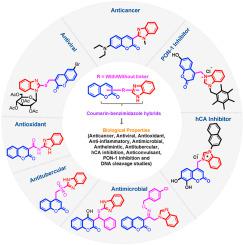European Journal of Medicinal Chemistry ( IF 6.0 ) Pub Date : 2021-10-20 , DOI: 10.1016/j.ejmech.2021.113921 Arya C G 1 , Ramesh Gondru 2 , Yupeng Li 3 , Janardhan Banothu 1

|
Coumarin and benzimidazole are privileged structures in medicinal chemistry and are widely used in drug discovery and development due to their vast biological properties. The pharmacokinetic and pharmacodynamic properties of the individual scaffolds can be improved by developing coumarin–benzimidazole chimeric molecules via molecular hybridization approach. The three major classes of coumarin–benzimidazole hybrids are merged, fused and spacer-linked hybrids. Depending on the substitution position, fused hybrids and spacer-linked hybrids can be further classified as coumarin-C3 hybrids, coumarin-C4 hybrids and coumarin-C5/6/7/8 hybrids. Most of the coumarin–benzimidazole hybrid molecules exhibited potent anticancer, antiviral, antimicrobial, antitubercular, anthelmintic, anti-inflammatory, antioxidant, anticonvulsant and carbonic anhydrase inhibitory activities. The fused coumarin-C3 hybrid (2), thiomethylene-linked coumarin-C3 hybrid (45), N-glucoside substituted thiomethylene-linked coumarin-C3 hybrid (37c), amide-linked coumarin-C3 hybrid (50a), and sulfonylmethylene-linked coumarin-C4 hybrid (63) were identified as the representative potent anticancer, antimicrobial, antiviral, antioxidant and antitubercular agents respectively. The biological properties of the different classes of coumarin–benzimidazole hybrids with their structure-activity relationship studies and the mechanism of action studies were presented in this review, aiming to help the researchers across the globe to generate future hybrid molecules as potential drug candidates.
中文翻译:

香豆素-苯并咪唑杂化物:药物化学发展综述
香豆素和苯并咪唑是药物化学中的特殊结构,由于其广泛的生物学特性,被广泛用于药物发现和开发。通过开发香豆素-苯并咪唑嵌合分子,可以改善单个支架的药代动力学和药效学特性分子杂交法。香豆素-苯并咪唑杂化物的三大类是合并的、融合的和间隔连接的杂化物。根据取代位置的不同,融合杂种和间隔物连接的杂种可进一步分为香豆素-C3杂种、香豆素-C4杂种和香豆素-C5/6/7/8杂种。大多数香豆素-苯并咪唑杂化分子表现出有效的抗癌、抗病毒、抗菌、抗结核、驱虫、抗炎、抗氧化、抗惊厥和碳酸酐酶抑制活性。稠合香豆素-C3杂合体( 2 )、硫亚甲基连接的香豆素-C3杂合体( 45 )、N-葡萄糖苷取代的硫亚甲基连接的香豆素-C3杂合体( 37c )、酰胺连接的香豆素-C3杂合体(50a ) 和磺酰基亚甲基连接的香豆素-C4 杂化物 ( 63 ) 分别被确定为具有代表性的强效抗癌剂、抗微生物剂、抗病毒剂、抗氧化剂和抗结核剂。本综述介绍了不同类别香豆素-苯并咪唑杂化物的生物学特性及其构效关系研究和作用机制研究,旨在帮助全球研究人员产生未来的杂化分子作为潜在的候选药物。











































 京公网安备 11010802027423号
京公网安备 11010802027423号